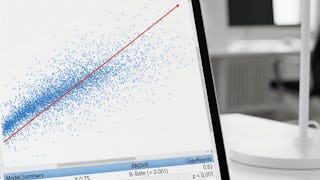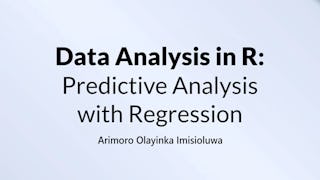Welcome to Predictive Modeling, Model Fitting, and Regression Analysis. In this course, we will explore different approaches in predictive modeling, and discuss how a model can be either supervised or unsupervised. We will review how a model can be fitted, trained and scored to apply to both historical and future data in an effort to address business objectives. Finally, this course includes a hands-on activity to develop a linear regression model.

Enjoy unlimited growth with a year of Coursera Plus for $199 (regularly $399). Save now.

Predictive Modeling, Model Fitting, and Regression Analysis
This course is part of Data Science Fundamentals Specialization

Instructor: Julie Pai
7,998 already enrolled
Included with
(73 reviews)
What you'll learn
The application of predictive modeling to professional and academic work
Applications of classification analysis: decision trees
Applications of regression analysis (linear and logistic)
Skills you'll gain
Details to know

Add to your LinkedIn profile
2 assignments
See how employees at top companies are mastering in-demand skills

Build your subject-matter expertise
- Learn new concepts from industry experts
- Gain a foundational understanding of a subject or tool
- Develop job-relevant skills with hands-on projects
- Earn a shareable career certificate

There are 4 modules in this course
Welcome to Module 1, Predictive Modeling. In this module we will begin with a comparison of predictive and descriptive analytics, and discuss what can be learned from both. We will also discuss supervised and unsupervised modeling, two foundational models in analytics and machine learning.
What's included
1 video2 readings1 discussion prompt
Welcome to Module 2, Data Dimensionality and Classification Analysis. In this module we will explore how data can be classified and how decision trees can be leveraged as a fast, easy to use a model that is easy to interpret, explain, and visualize.
What's included
2 readings1 assignment
Welcome to Module 3, Model Fitting. In this module we will explore the concept of model fitting and how creating a generalized model that is able to fit both historical and future data is the ultimate goal. We will also review how a model can be trained or scored to apply to new and unlabeled data.
What's included
1 video2 readings1 discussion prompt
Welcome to Module 4, Regression Analysis. In this module we will begin with an explanation of regression analytics, a popular technique used by data science professionals to make predictions. We will also discuss how achieving model fit is not a guarantee that a model can help solve a business problem, and how even a good model can sometimes lead to unactionable outcomes.
What's included
2 readings1 assignment1 discussion prompt
Earn a career certificate
Add this credential to your LinkedIn profile, resume, or CV. Share it on social media and in your performance review.
Instructor

Offered by
Explore more from Data Analysis
 Status: Free Trial
Status: Free TrialUniversity of Minnesota
 Status: Preview
Status: Preview Status: Preview
Status: Preview
Why people choose Coursera for their career




Learner reviews
73 reviews
- 5 stars
69.86%
- 4 stars
17.80%
- 3 stars
5.47%
- 2 stars
2.73%
- 1 star
4.10%
Showing 3 of 73
Reviewed on Jan 27, 2022
good course to understand the fundamentals of predictive analysis
Reviewed on Sep 17, 2023
This course helped me to apply regression techniques on my current job assignments
Reviewed on Jan 11, 2022
course content is very concise and easy to understand

Open new doors with Coursera Plus
Unlimited access to 10,000+ world-class courses, hands-on projects, and job-ready certificate programs - all included in your subscription
Advance your career with an online degree
Earn a degree from world-class universities - 100% online
Join over 3,400 global companies that choose Coursera for Business
Upskill your employees to excel in the digital economy
Frequently asked questions
To access the course materials, assignments and to earn a Certificate, you will need to purchase the Certificate experience when you enroll in a course. You can try a Free Trial instead, or apply for Financial Aid. The course may offer 'Full Course, No Certificate' instead. This option lets you see all course materials, submit required assessments, and get a final grade. This also means that you will not be able to purchase a Certificate experience.
When you enroll in the course, you get access to all of the courses in the Specialization, and you earn a certificate when you complete the work. Your electronic Certificate will be added to your Accomplishments page - from there, you can print your Certificate or add it to your LinkedIn profile.
Yes. In select learning programs, you can apply for financial aid or a scholarship if you can’t afford the enrollment fee. If fin aid or scholarship is available for your learning program selection, you’ll find a link to apply on the description page.
More questions
Financial aid available,


